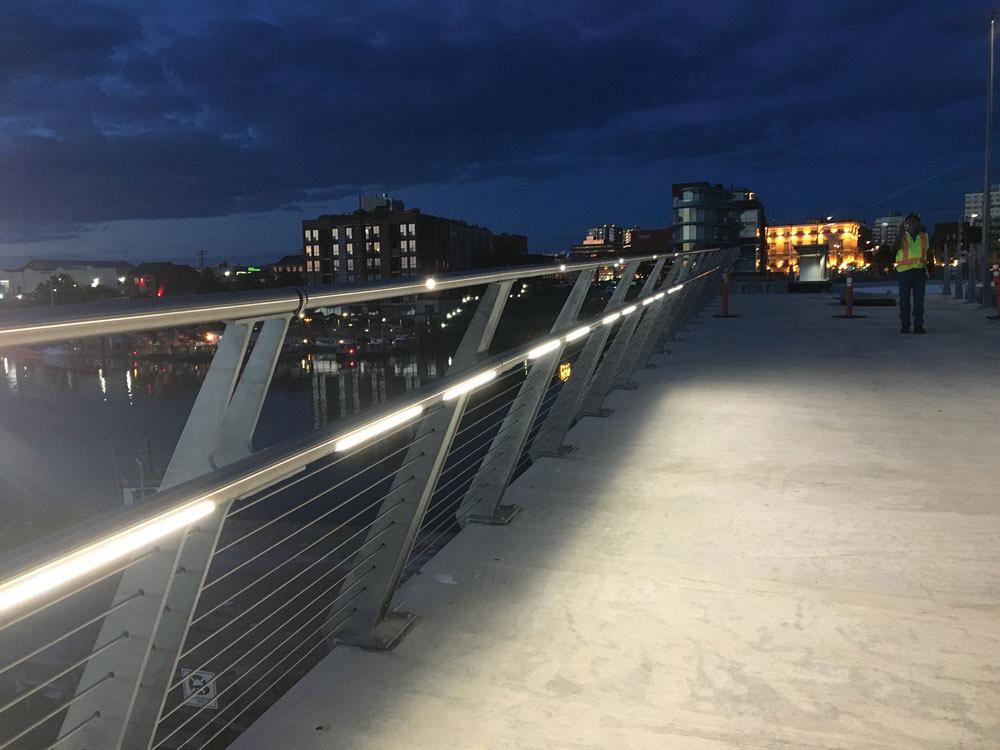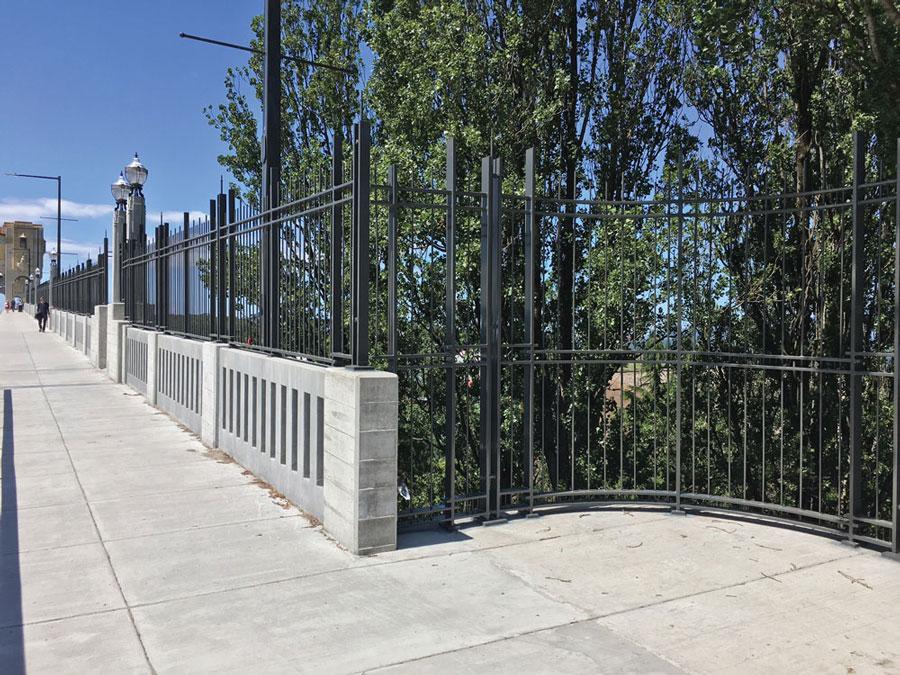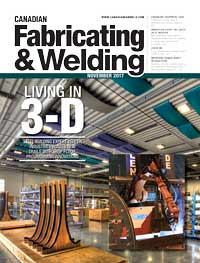Editor
- FMA
- The Fabricator
- FABTECH
- Canadian Metalworking
Innovation keeps the lights on at Marcon
Custom fab shop Marcon Metalfab keeps agile by developing its own products and investing in cutting-edge machines, management processes
- By Rob Colman
- November 21, 2017
- Article
- Fabricating

Johnson Street bridge in Victoria, B.C., which incorporates Marcon’s new guardrails with integrated LEDs. Image courtesy of Marcon.
Marcon Metalfab, Delta, B.C., is a shop known for its custom fabrication work in the transportation, building construction, and utilities industries. The company’s ability to cover customers’ needs from design to installation has been aided by the owner’s willingness to invest in the latest technologies to ensure jobs are done accurately and on time. These investments also have made it possible for Marcon to develop its own products that meet specific needs in the transportation sector.
Tech Investments: The Right Tools for the Job
The Marcon company name dates back to the 1980s. When current owner and President Ari Burstein bought the business in the late 1990s, it was a small, 3,000-sq.-ft. shop. The business now sits on a 2.3-acre lot with two 25,000-sq.-ft. buildings in which all the fabrication is done. While that’s a sizable footprint, when you’re working on large transportation or construction jobs with large assemblies, the free floor space disappears quickly.
“The purchase of the right machinery has meant that we can process a lot of steel while fitting and fabricating is also taking place,” said General Manager Mike Moffat. “Space is a challenge here. We were processing a lot of work before we invested in much of this equipment, but this has made us more efficient.”
The list of cutting-edge technologies on the shop floor is a long one, but as a taste, it includes three robotic welding stations, a PythonX CNC plasma cutting system for beam cutting and coping, a Mazak 3D Fabri Gear 400 II tube cutting system, and most recently added was a Mazak Optiplex 4020 Fiber laser for sheet processing.
Moffat’s matter of fact when it comes to the value of these technologies on the shop floor; each has its place, but none magically changes the way the shop works.
“Consider robotic welding. Welding can still be a bottleneck on the shop floor sometimes because not every job is suited to being automated,” he said. “Sometimes it’s faster to just run a bead on a job rather than programming it. But we purchased our first welding cells to help out with welding posts for bridge barrier rails. With a repetitive job like that, a robot makes a lot of sense. But because we’re a custom fab shop, we can’t always do that.”
Guardrail Innovations
Like any job shop, Marcon invests in technology that can help improve its speed of delivery. Because it has developed a certain expertise in transportation work, there are certain products it is confident will be in the pipeline for some time – for instance, guardrails.
The laser tube cutting machine was something of an unexpected investment when Marcon purchased it, but it turned out to be a boon for the company in this particular area.
“Initially we weren’t even shopping for a laser,” said Burstein. “We went to FABTECH looking for automated saws to help speed up the processing of guardrails. We knew about the abilities of the laser, but the cost was comparatively high. But once we saw what the laser could do, we knew we wanted it. We also could see that we could keep it busy 40 per cent of the time with work we already had.”
They also found that they could upgrade what they were offering clients. To be precise, they designed a guardrail with integrated LED lights.
“We landed the Johnson Street bridge contract in part because we were able to design this integrated guardrail based on the capabilities of the tube laser,” said Burstein.
“All LED handrailing before this always consisted of an extruded pipe with LEDs glued to them. The electrical is fed down to the lights and is clipped in,” said Moffat. “That is not a durable product. And if you can destroy something like that, someone eventually will. Our design involves cutting a thin channel into which the LEDs are fitted. It cannot be broken, and once it is installed, you can’t get the LED lights out without the correct tool.”
It’s the precision of the laser that allows Marcon to make this product. The Mazak tube cutting machine has a 4-kW laser and can process structural beams, tube, and pipes. This particular model handles round pipe diameters up to 16 in. The laser is a 6-axis model. With its tight tolerances, it can handle drilling and tapping operations as well.
The LED guardrail is just the latest product that Marcon has designed. It also has its own line of expansion joints.
Keeping Everyone Accountable: Electronic Job Management Advances
Marcon runs seven days a week with both a day shift and an afternoon shift. The shop has 98 team members, including its installation crew and office staff. Staying on the ball with respect to jobs on and off the floor would seem to be the biggest challenge that Burstein and Moffat have to manage. However, probably the most intriguing investment Marcon has made is the development of its own electronic job management system.
“We try to be efficient in everything we do,” said Burstein. “Manufacturing in North America is not exactly thriving, and a lot of people believe that it’s because it’s just cheaper to produce goods elsewhere. That may be true, but all of the countries that are thriving in manufacturing are investing in new machinery. If you visit Ficep in Italy, its equipment is going all over the world, but very little of it comes to North America. You’ve got to put money back into your business. And when you buy new machinery, you have to invest in the technology that is going to help those machines run efficiently. That’s what we’ve done with this system.”
“We looked around for a system that could do everything we wanted it to do and couldn’t find it, so we designed our own system,” said Moffat. “Everyone in the shop has access to it. If someone leaves a note on a drawing, everyone has access to the drawing and the note. When it comes to processing parts, we know what machine is running and on what project. We track every project on all the different machines. We have full material traceability. You can look at, for instance, our Ficep plasma table and see what is currently in programming. You can also see what has been completed on that machine and what’s to come next on it. You can also review the nesting and all the material certification.”
The system Marcon currently uses has evolved over time from a chalkboard, to magnets, to an Excel sheet, until finally the company hired someone full-time to do the programming. The program has continued to evolve over the past 10 years.
“Two years ago we integrated a quality control program into the system,” said Burstein. “For instance, the welders get prompts asking them if they have completed certain tasks. They have to sign off with their name and the date next to each item.” This also gives employees the opportunity to compare their performance to those of their colleagues.
“People can compare their performance with how others run the same machine,” said Burstein. “We have a natural competitiveness, so when you see how you’re running your station compared to your colleagues, it’s a natural instinct to want to pick up your game.”
When Canadian Fabricating & Welding visited the Marcon shop, Burstein was looking at methods for tying machine information into the program to post real-time capacity numbers on the system as well.
Burstein appreciates that, with the system, he can easily see what is happening on the shop floor at any time.
“When a drawing gets sent to the floor, it’s tagged with the name of the machine it’s going to,” he said. “We know when a part is cut and by whom. It creates better communication between the guys. That’s particularly helpful when you have multiple shifts. And for me, if something needs to be rushed and it’s not being worked on, for whatever reason, I can go down and talk to the foreman and arrange for that job to be pushed through.”
It's also valuable for clients. They are able to check in on the progress of their orders as well through a secure website.
Raising the Bar
Although bridge work isn’t all that Marcon does by a long shot, it’s certainly keeping the company busy right now. Work in the pipeline or recently completed includes Burrard Street Bridge in Vancouver, Johnson Street Bridge in Victoria, and all of the bridge work for the Calgary ring road, which includes 48 bridges.
With all the shop’s clients, Burstein is confident that the Marcon name has come to be seen as a reliable go-to partner.

Originally built in 1927, the Hudson’s Bay Company’s Vancouver store underwent a rejuvenation in 2012. The highlight of this project are the four feature canopies that Marcon fabricated and installed. Along with the rest of the project team, Marcon received a Heritage Merit Award from the City of Vancouver “for the recreation of the historic ground floor entrance canopies.” Image courtesy of Marcon.
“We’ve raised the bar of what they expect from working with a fabricator,” said Burstein.
Editor Robert Colman can be reached at rcolman@canadianfabweld.com.
Marcon Metal Fabrication, 604-940-0977, www.marconmetalfab.comAbout the Author

Rob Colman
1154 Warden Avenue
Toronto, M1R 0A1 Canada
905-235-0471
Robert Colman has worked as a writer and editor for more than 25 years, covering the needs of a variety of trades. He has been dedicated to the metalworking industry for the past 13 years, serving as editor for Metalworking Production & Purchasing (MP&P) and, since January 2016, the editor of Canadian Fabricating & Welding. He graduated with a B.A. degree from McGill University and a Master’s degree from UBC.
subscribe now


Keep up to date with the latest news, events, and technology for all things metal from our pair of monthly magazines written specifically for Canadian manufacturers!
Start Your Free Subscription- Trending Articles
Orbital tube welding webinar to be held April 23

Portable system becomes hot tech in heat treatment

Cidan Machinery Metal Expo 2024 to be held in Georgia May 1-2

CWB Group launches full-cycle assessment and training program

Achieving success with mechanized plasma cutting

- Industry Events
MME Winnipeg
- April 30, 2024
- Winnipeg, ON Canada
CTMA Economic Uncertainty: Helping You Navigate Windsor Seminar
- April 30, 2024
- Windsor, ON Canada
CTMA Economic Uncertainty: Helping You Navigate Kitchener Seminar
- May 2, 2024
- Kitchener, ON Canada
Automate 2024
- May 6 - 9, 2024
- Chicago, IL
ANCA Open House
- May 7 - 8, 2024
- Wixom, MI


















